The 1990s ushered in a revolution in precision attack. The 2000s made unblinking Air Force intelligence, surveillance, and reconnaissance a prerequisite for joint operations.
Unblinking is the key here. In the Cold War, the Soviet Union changed slowly, so occasional satellite overflights or U-2 missions were often good enough to track the evolving threats. Today, the threats are smaller, more adaptive, and more numerous. Military commanders demand the ability to watch certain areas—or even individuals—for long periods and with zero interruptions.
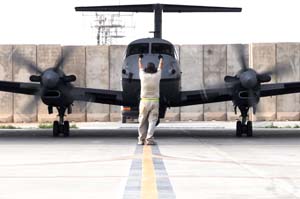
| ||
|
A crew chief marshals an MC-12 Liberty at JB Balad, Iraq, in 2010. The light aircraft remains a valuable intelligence, surveillance, and reconnaissance asset in Afghanistan’s low-threat environments. (USAF photo by SrA. Brittany Y. Bateman) |
Although the war in Iraq is over and Afghanistan is winding down, the momentum for ISR capability continues. The rapid ascent of ISR has made it tough to determine how best to modernize and improve future ISR capability. First, although space assets are and will remain critically important in this realm, the huge expansion in capabilities over the past decade took place in a wide range of air-breathing platforms.
The unblinking eye is really a set of ISR capabilities, from fine-tuned 30 frames per second video covering a tiny area to sophisticated radar tracks spanning whole swaths of a country.
Modernization decisions are often difficult and expensive. While USAF plans to spend $7.1 billion in Fiscal 2013 alone on its ISR enterprise, it isn’t buying many new platforms for future requirements. Already, the annual buy rate of the MQ-9 Reaper has been cut in half from 48 to 24, and MQ-1 Predator production ceased in 2011. USAF is angling to transfer most of its MC-12s from the active to the reserve components in part to save money. In fact, it’s the Department of the Navy that has 185 new wide-area surveillance aircraft on order. The Air Force is struggling to set a new course as it reshuffles ISR for a range of contingencies that must soon include peer competitors cloaked by anti-access defenses.
Can USAF muster the momentum to keep open the joint force’s unblinking eye?
War Surplus
What USAF has on its hands is a war surplus air-breathing ISR fleet teeming with video sensors mounted on large and small aircraft. The Air Force flies upward of 1,500 hours per day with its ISR aircraft, and two-thirds of those are video collectors focused on extremely small segments of the battlespace.
Predators, Reapers, and MC-12s remain valuable for low-threat airspace. Indeed, the Air Force is moving forward with upgraded sensor packages to expand the number of spots each aircraft can monitor at once.
At present, each Predator, Reaper, or MC-12W Liberty on patrol focuses on one spot. However, new wide-area motion imagery (WAMI) packages such as the Gorgon Stare system will enable a single ISR aircraft—manned or unmanned—to cover several areas at once. With Gorgon Stare, the Predator can establish a citywide view or isolate simultaneous spot image areas with greater resolution.
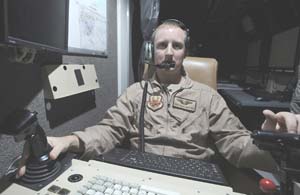
| ||
|
SSgt. Christopher Watford controls an MQ-1B Predator’s sensors during a mission. The Predator and Reaper fleets look at small areas in permissive airspace, but they weren’t designed for long-term wide-area surveillance or hostile air environments. ( |
The Defense Advanced Research Projects Agency has developed another wide-area imaging process called Autonomous Real-time Ground Ubiquitous Surveillance, or ARGUS, which can cover about 40 square miles. Neither provides quite the crisp frame rate of the current systems at 30 frames per second. Still, the systems multiply coverage greatly.
The wide-area systems can also produce many more spots of coverage, and that leads to more data. Gorgon Stare offers 10 spot images from each ISR aircraft. ARGUS has the potential for 65. However, either could break the bank on manpower—unless USAF makes changes in how it handles processing, exploitation, and dissemination (PED).
“It is clear to all that imposing PED requirements on WAMI video chips that are identical to those for current narrow-field-of-view FMV [full-motion video] sensors would lead to an unsustainable rate of growth in PED manpower,” a 2012 RAND study led by Lance Menthe found. “Naïvely multiplying the motion imagery crew size by the number of motion imagery spot equivalents, we see that by 2015, the Air Force could, in theory, require up to 117,000 personnel dedicated to motion imagery exploitation alone—one-third of the Active Duty Air Force.”
The RAND authors suggest automated target recognition to alert human analysts when it is time for eyes-on image analysis. Assuming USAF finds software solutions for better processing, the fact remains the multispectral video field of regard is too small to find theaterwide trends or track large swaths of moving elements—be they terrorists or refugees. On a larger scale the effect is akin to multiplying soda straws.
Keeping watch over the Pacific or contested areas of the Persian Gulf region could well demand surveillance much more survivable than the Predator or Reaper. Capable as it is, today’s fleet looks at small areas in permissive airspace and just wasn’t designed for long-term wide-area surveillance or hostile air environments.
Thinking Big
Radar sensors remain the key to an unblinking eye for theaterwide views, all-weather imaging, and track detection. For example, the E-8 JSTARS, in wide-area surveillance mode, can cover an area spanning 19,000 square miles. No amount of video sensors can match the sweep.
There’s no question that radar-based motion intelligence is essential to the force mix. It proved its worth again and again during the long wars in Afghanistan and Iraq. For example, a JSTARS aircraft pinpointed moving Iraqi forces during a sandstorm in the second week of Operation Iraqi Freedom, and US forces relied on it frequently in Afghanistan as well.
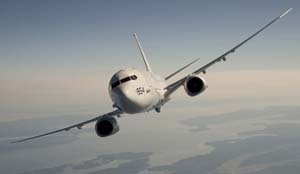
| ||
|
Navy plans call for 117 new P-8 surveillance aircraft, such as the one shown here. The P-8 will become operational in 2013. ( |
Most of all, demand for wide-area surveillance and ground moving target indicator (GMTI) radar is not a thing of the past. The Global Hawk Block 40 that will carry GMTI entered the force in 2009. South Korea requested deployment of a JSTARS to monitor North Korean forces during tensions in late 2010.
In Libya in 2011, JSTARS was immediately deployed to help sort out ground positions of rebel forces and Qaddafi loyalists. Distinguishing rebel fighters from regime forces took on special importance because the area had not been a priority ISR target.
Army Gen. Carter F. Ham, US Africa Command boss, attested to the value of JSTARS for intelligence about Qaddafi loyalist and rebel forces. “Joint STARS has been an integral and important component of the suite of collection assets which the US and others have applied to operations in Libya,” Ham told Congress. “Joint STARS’ particular capability in detecting moving forces has been particularly useful and noteworthy, especially early on in the campaign where the regime forces were moving, Joint STARS was able to identify those and greatly aided the vectoring in of aircraft to interdict some of those efforts.”
Wide-area surveillance is likely to be even more important as US forces shift to monitoring hotspots and characterizing threats in low- to medium-intensity conflicts.
Then there is the challenge of near-peer surveillance. Insurgents in trucks are not the only targets. Mobile military targets such as missile launchers or hostile RPAs require unbroken surveillance to discern habits and make inroads in shutting down attacks.
Failed Attempts
However, the Air Force’s path for investing in wide-area surveillance is especially tricky, and the track record is not encouraging. USAF has been trying for years to find a modernization solution.
A concept for a space-based system for radar imaging surfaced in the late 1990s as an attempt to migrate radar surveillance functions, including GMTI, from aircraft onto a new platform in space. By 2002, space-based radar was a pathfinder program with significant backing from the Office of the Secretary of Defense, but was later terminated due to cost and concern about technology readiness.
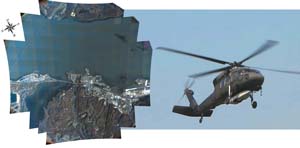
| ||
|
A Blackhawk helicopter equipped with an integrated ARGUS pod. The wide-area imaging process can cover some 40 square miles in photographs such as at left. ( |
USAF also tried to develop a new widebody Boeing 767 platform for ISR: the E-10. In the early 2000s, the E-10 was intended to replace the E-3 AWACS, E-8 JSTARS, and RC-135 Rivet Joint. Work began in May 2003 when a team led by Northrop Grumman, Boeing, and Raytheon won a $215 million contract to start preliminary system development and demonstration on a new aircraft. It was to be a command and control constellation, “a fully connected array of land, airborne, and space-based sensors that use common standards and communication protocols to relay information automatically in machine-to-machine interfaces,” as the Air Force described it.
However, the full E-10 program was canceled in February 2007. Again, concerns about cost and immature technology caused leaders to pull the plug. Cancellation of the E-10 deferred questions about where to take the mission.
Costs unquestionably played a big role in this double failure. The pitfall in both cases was betting too much on immature technology and failing to agree on an operational concept for all users.
The Air Force in 2010 began working through an analysis of alternatives on GMTI long-range solutions including upgrades and new manned and unmanned aircraft and airships.
The basic plan was to re-engine and modify 17 JSTARS aircraft while adding 22 Global Hawk Block 40s. The Air Force was also exploring other platforms for GMTI, such as Reaper, a new MQ-X unmanned aircraft, or even airships.
An analysis of alternatives provided no actionable path forward. The study concluded that the best option was to retire JSTARS, keep the Global Hawk Block 40 with its GMTI sensors, and add a new aircraft: a business jet like the Gulfstream equipped with a new radar.
The Air Force had already cut back the buy of Block 40 Global Hawk from 22 to 11, and the business jet-based system was deemed simply unaffordable. “The reality is that there is not enough space [in the budget] to undertake a new start, business-class ISR platform,” Schwartz testified in March.
Air Combat Command never released the study because it contained too much proprietary information.
“The GMTI capability is something we need,” Deputy Chief of Staff for Plans and Programs Lt. Gen. Christopher D. Miller said in March. “There are probably cheaper ways to get through it over the long term, [but] every other way of accomplishing that mission requires investment.”
Growing Demand
Ample radar-based imaging is essential for wide-area surveillance. Combatant commanders have no plans to scale back global ISR requirements. Some, such as US Southern Command Commander Gen. Douglas M. Fraser talked openly of their need for persistent ISR. “I’m a combatant commander,” Fraser said in March. “I could always use more ISR. I’m not different than anybody else.”
The GMTI and synthetic aperture radar combination is the only all-weather source for motion intelligence because it is based on sophisticated interpretation of radar return.
It doesn’t take a major conflict to kick wide-area surveillance demand into high gear. Requests for GMTI surveillance may be spread across geographic areas. Take the basic case of “pattern of life” analysis of a suspicious compound. Forces may receive a cellular phone indication. Then they must shift wide-area coverage to survey the site patiently.
In good weather, with permissive airspace, a Predator or Reaper may circle in for close-up full-motion video. But insurgents are wise to many of the ways they are watched. They may choose to wait for night and cloud cover before gathering in hopes of evading detection. But there’s little hope of concealment if a radar-imaging aircraft is on hand producing images and catching movement tracks.
As Fraser acknowledged, the requirements in each region are specific. While he rated SOUTHCOM’s current allocation as “OK,” he also pointed out the need for “more maritime capacity.”
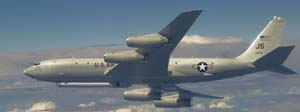
| ||
|
The E-8C JSTARS test bed (T-3) during tests of the MS 177 multispectral sensor, currently used on the U-2. ( |
Not coincidentally, it is the Navy that is rolling out major theater ISR platforms. Two big Navy programs for land-based aircraft will dominate ISR aircraft acquisition for the next several years. Navy plans call for 117 new P-8 surveillance aircraft and a projected 68 MQ-4 adapted Global Hawks for its Broad Area Maritime Surveillance (BAMS) mission. The P-8 will reach operational capability in 2013 and the BAMS MQ-4 in 2015.
Of course, the Navy recapitalization is designed to carry out maritime patrol and anti-submarine warfare missions. The Navy is buying BAMS as an adjunct to the P-8, and the mission will be to provide combat information to operational and tactical users such as carrier strike groups, according to Naval Air Systems Command.
Chief of Naval Operations Adm. Jonathan W. Greenert praised a demonstrator BAMS at work in the Persian Gulf and operating often over the Strait of Hormuz. “The BAMS-D remains heavily used. The theater commander loves it. He’s sort of addicted to it,” Greenert said. “We use it on every strait transit. Somebody goes out ahead. It’s a nice view of who’s out there.”
Can the Navy P-8s and BAMS Global Hawks contribute to the kinds of ISR missions flown by USAF aircraft today? Navy MQ-4s will post information to the Global Information Grid (GIG) and support a variety of intelligence activities and nodes. In a secondary role, the BAMS Global Hawk will also be used alone or in conjunction with other assets to respond to theater-level operational or national strategic tasking.
The radar capability will be there to contribute to national intelligence requirements and combatant commander ISR needs. But under current Navy plans, the joint force maritime component commander will likely control the new P-8s and BAMS.
USAF leaders are well aware that conquering denied airspace is one of the biggest ISR challenges, and also have other solutions in mind.
Stealthy, survivable ISR platforms are set to become an important part of the ISR inventory. Glimmers of new unmanned systems include the Lockheed Martin RQ-170 Sentinel. For stealth ISR collectors, USAF also has the F-22 and F-35 for the mission known as nontraditional ISR. The name is somewhat misleading simply because using top-line fighters for surveillance and reconnaissance became a common practice during missions in Afghanistan and Iraq.
Facing the Tests
“Before NTISR, we had fighter aircraft with surveillance capabilities burning holes in the sky, just waiting to be tasked by ground commanders,” said Maj. Marco Fiorito, who was deputy chief of collections management at the combined air operations center in 2006. “Instead of wasting these resources, we’ve begun to use them to fill some of the gaps in our traditional ISR operations,” Fiorito said.
Fighters with active electronically scanned array (AESA) radars and other sensors are capable of acting as highly sophisticated ISR collectors. The F-35 has two major potential ISR collectors in its suite, the AESA radar and a Distributed Aperture System, or DAS, which offers 360-degree tacking capability for its electro-optical and infrared sensors.
One role of the DAS is to assist navigation and support for the F-35—but it has also proved capability in areas such as ballistic missile launch point detection and tracking. AESA radars have inherent radar collection abilities that can be calibrated for imaging, signals, and a variety of other applications. All signs are that USAF will be counting on the stealth fighters to become part of the ISR suite, and to assert the unblinking eye in denied airspace.
In the years ahead, the unblinking eye of Air Force ISR may spread from air and space and into cyberspace, too—if it is not there already. Officials have hinted cyber intelligence will become a bigger part of the picture.
The cyber contribution to ISR has two parts. One may in fact be collection. When and whether “cyber ISR” compensates for other types of collection is yet to be determined.
At the same time, cyber systems already form the backbone of ISR processing. The task ahead is to do it much, much better. Lt. Gen. Larry D. James, head of ISR on the Air Staff, stressed that ISR products will be network-centric. “ISR in the cyber domain is an area that needs more attention and an area where we’re starting to see more investment,” he explained in February at Air Force IT Day. In practice, this means improving database tools and access so authorized users can pull imagery from a cloud-type architecture. Another refinement would be adding the ability for the database to push imagery or other intelligence to the user based on a designated set of criteria.
USAF’s capacity for unblinking ISR faces several tests. However, there’s little question that for airmen, ISR is a major and growing mission area. And it will be airmen who ensure its future.
“When it comes down to the end of the day,” said James in June, “how fancy the hardware or technology is doesn’t matter—somebody has to make sense of it, execute it, and provide it, and that’s the people.”
Rebecca Grant is president of IRIS Independent Research. Her most recent article for Air Force Magazine was “Adaptive Engines” in the September issue.
